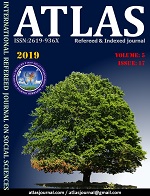SİRKADİYEN RİTİM, UYKU VE BESLENMENİN OBEZİTE ÜZERİNE ETKİLERİ
DOI:
https://doi.org/10.31568/atlas.297Anahtar Kelimeler:
Krono-nütrisyon, obezite, sirkadiyen, uyku bozukluklarıÖzet
Diyabet, kardiyovasküler hastalıklar, kanser ve solunum sistemi hastalıkları başta olmak üzere pek çok hastalığın gelişiminde anahtar rol oynayabilen ve çağımızın vebası olarak nitelendirilen obezite, prevelansı giderek artan büyük bir halk sağlığı sorunudur. Hareketsiz yaşam tarzı, aşırı ve yanlış beslenme alışkanlıkları, hormonal ve metabolik etmenler gibi birçok faktörün obezite oluşumuna zemin hazırlayabildiği bilinmektedir. Bunların yanı sıra tek hücreli canlılardan insanlara kadar tüm organizmalarda önemli biyolojik düzenleyiciler olan sirkadiyen ritim bozukluklarının da obezite prevelansında artışa neden olabileceği düşünülmektedir. Ortalama 24 saatlik döngüye sahip biyolojik ritimler olarak da adlandırılan sirkadiyen ritimlere verilebilecek en güzel örnek kişinin uyku-uyanıklık döngüsüdür. Bu derleme çalışmada sirkadiyen ritim, uyku ve beslenmenin obezite oluşumu üzerine etkileri incelenmiştir. Beynin ön tarafında bulunan Suprakiazmatik Nükleus (SKN) tarafından kontrol edilen sirkadiyen ritimler gece-gündüz, yaz-kış gibi çevresel koşullardan etkilense de genellikle dış etkenlerden bağımsız olarak çalışan endojen mekanizmalardır. SKN’nin direkt etkilediği mekanizmalar arasında beslenme, uyku uyanıklık döngüsü, glikoz metabolizması, insülin salınımı gibi önemli metabolik olaylar yer almaktadır. Kısa süreli veya düzensiz uykunun obezite üzerine etkilerini araştırmak için yapılan pek çok çalışmada, uyku yoksunluğunun leptin düzeylerindeki düşüş ve ghrelin düzeylerindeki artışla birlikte seyrettiği görülmüştür. Beslenme, uyanıklık ve enerji tüketiminin kontrolünü sağlayan oreksin sisteminin bir parçası olan bu hormonlar arasındaki dengesizlik, tokluk hissinin azalıp açlığın artmasını, yağ ve karbonhidrat içeriği yüksek besinlere olan eğilimi, artan atıştırmalık tüketimini açıklayabilmekte ve sonunda kilo alımına neden olabilmektedir. Sirkadiyen ritim, uyku ve beslenme alanındaki çalışmalar henüz çok yeni olup tutarlı sonuçlar elde edilebilmesi için bu alanda yapılacak daha kapsamlı çalışmalara ihtiyaç vardır.
İndir
Yayınlanmış
Nasıl Atıf Yapılır
Sayı
Bölüm
Lisans

Bu çalışma Creative Commons Attribution-NonCommercial 4.0 International License ile lisanslanmıştır.


